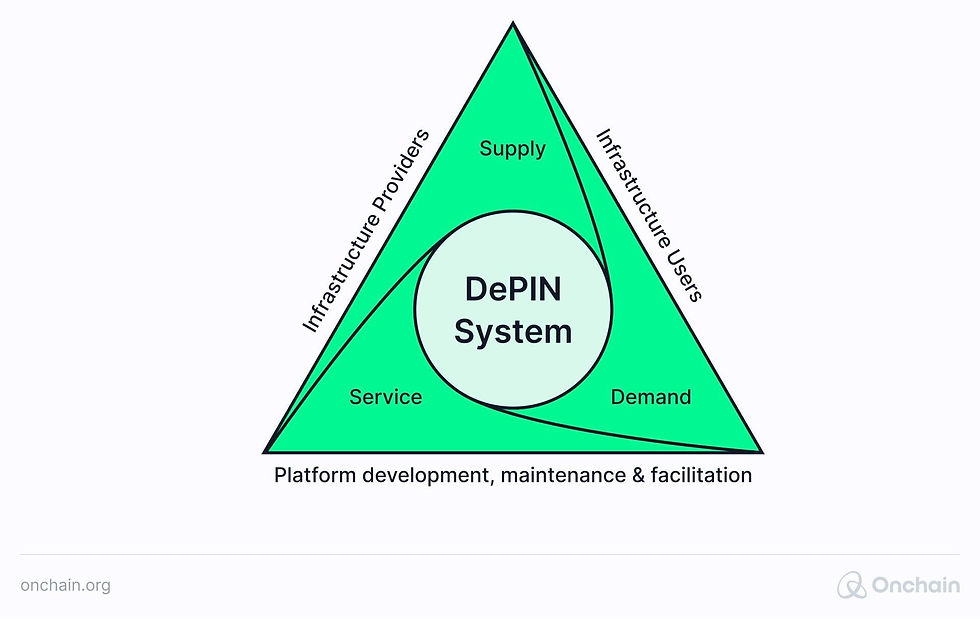DePIN's Emerging Frontier: How Underserved Markets Are Driving the Next Wave of Decentralized Infrastructure
- Gator

- 6 hours ago
- 4 min read

Introduction
In the sprawling ecosystem of decentralized physical infrastructure networks (DePIN), where blockchain meets real-world utility, a surprising shift is underway. While Silicon Valley and traditional tech hubs once dominated innovation, the true growth story of 2025 is unfolding in emerging markets like the Middle East, Southeast Asia, and South America. These regions, plagued by infrastructure gaps in connectivity, energy, and logistics, are embracing DePIN to leapfrog legacy systems, attracting $150 million in capital during Q1 alone and projecting a $3.5 trillion market by 2028. As Bitcoin hovers at $107,820 amid U.S.-China trade tensions and vulnerabilities like the NPM malware attack expose the sector's risks, DePIN's rise in underserved areas signals a pivot: from hype-driven pilots to practical solutions for billions. But can this momentum sustain, or will regulatory fragmentation and security threats derail the revolution? This is the story of DePIN's global rebalancing, where necessity breeds innovation.
The Shift: DePIN's Move to Emerging Markets
DePIN, which leverages blockchain to crowdsource physical infrastructure like wireless networks and energy grids, is finding fertile ground where traditional systems fail. Emerging markets, characterized by unreliable connectivity and high costs, are ideal testing beds. The Middle East, Southeast Asia, and South America saw 52% year-over-year growth in DePIN activity, outpacing North America's 24% venture capital share of global funding. This surge is fueled by regulatory sandboxes and state-backed initiatives that prioritize Web3 over legacy tech.Take the UAE: Dubai's Virtual Assets Regulatory Authority (VARA), established in 2022, offers tailored sandboxes for DePIN projects, fostering innovation in a region expecting 7,100 new crypto millionaires in 2025. Abu Dhabi's $500 million Digital Energy Infrastructure Fund targets blockchain applications, blending DePIN with renewables to address energy access for 40% of its population. In Southeast Asia, Vietnam's national blockchain strategy, launched in late 2024, introduced the NDAChain platform for e-government and digital economy, focusing on finance, logistics, agriculture, and data management. Singapore's Monetary Authority (MAS) supports tokenizing real-world assets through Project Guardian and the Blockchain Innovation Programme, with state funds like Temasek and GIC investing $180 million in regional projects.South America, meanwhile, leverages DePIN for connectivity. Helium, a wireless network protocol, has deployed 380,000 hotspots globally, with rapid expansion in Mexico and Brazil, where Movistar subscribers average 390 megabytes of daily data—equivalent to seven hours of web browsing—on the network. These markets aren't chasing vanity metrics; they're solving acute needs, like Vietnam's rural internet gaps or Dubai's energy diversification.
The Drivers: Regulatory Clarity and Real-World Needs
Emerging markets' DePIN boom stems from two forces: progressive regulations and infrastructure voids. Unlike the U.S., where the GENIUS Act focuses on stablecoins and the SEC's ETF standards lag, regions like Singapore and the UAE offer sandboxes that fast-track pilots. MAS's fintech framework has licensed 19 crypto firms, while VARA's approvals enable DePIN to test tokenized energy grids without red tape. This contrasts with North America's regulatory caution, where FCC approvals delay wireless projects by years.Real-world demands amplify the appeal. In Vietnam, where 40% lack reliable internet, DePIN networks like Helium provide affordable hotspots, earning users tokens for sharing bandwidth. South America's logistics challenges—Brazil's port delays cost $20 billion annually—find solutions in tokenized supply chains on platforms like VeChain. The Middle East's energy transition, with Dubai aiming for 100% clean power by 2050, uses DePIN for decentralized solar grids, rewarding participants with tokens for excess energy.This bottom-up approach has drawn smart money: Temasek led a $110 million round in Animoca Brands, while GIC invested $70 million in Hong Kong's BC Group. The result? DePIN's $150 million Q1 funding, a 52% regional growth rate, and a projected $3.5 trillion market by 2028, per Messari.
Challenges: Fragmentation, Security, and Scalability
DePIN's promise in emerging markets is tempered by hurdles:
Regulatory Patchwork: Singapore's MAS and UAE's VARA foster innovation, but Indonesia's bans and India's 30% crypto tax create silos, stifling cross-border projects. The article's optimism overlooks how U.S. GENIUS Act focus on stablecoins leaves DePIN in a gray zone.
Security Vulnerabilities: The NPM attack and $40 billion in illicit flows highlight risks, with DePIN's physical-digital blend inviting hacks like North Korea’s $1.3 billion exploits. The article downplays how tokenized grids could amplify threats.
Scalability Gaps: Helium's 380,000 hotspots are impressive, but Vietnam's rural connectivity lags, with only 30% reliable internet. The article assumes seamless adoption, ignoring infrastructure costs estimated at $10–20 billion regionally.
Adoption Barriers: Community-driven models require literacy, yet 51% of Sub-Saharan Africans are unbanked. The article understates education needs.
Economic Risks: DePIN's token incentives risk speculation, with the Crypto Fear & Greed Index at 71 (“Greed”) signaling froth.
The Broader Picture: DePIN's Global Ripple Effect
DePIN's emerging market focus reflects Web3's democratization. Sub-Saharan Africa’s 52% growth, Venezuela’s USDT surge, and Asia’s block space shift show utility, per Reuters. Institutional inflows ($29.4 billion ETFs) contrast with the NPM attack, per CCN. If DePIN scales, it could unlock $3.5 trillion, but failure risks widening divides.
Conclusion: Emerging Markets as DePIN's True North
DePIN’s $150 million Q1 funding and projected $3.5 trillion market by 2028 position emerging markets as Web3’s growth engine, solving connectivity and energy gaps with blockchain. UAE’s VARA sandboxes, Vietnam’s NDAChain, and Helium’s hotspots showcase progress, but regulatory silos, security risks like NPM, and scalability demand action. As Bitcoin dips and regulations evolve, builders must prioritize real needs over hype. Investors should monitor Temasek’s investments and MAS pilots, while policymakers need inclusive frameworks. In a market of greed and fear, DePIN’s future shines brightest where necessity meets innovation.





Comments